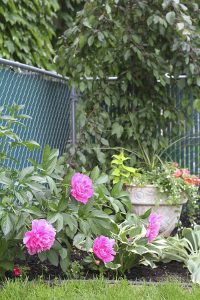Hello Friends! You know it’s that time of year when you’ve got to starting thinking about all that boring, tedious, endless yard work you’ve got comin’ at cha. That’s how most people see it anyway, but I actually find a lot of satisfaction from getting my garden in tip-top shape. It helps knowing that that extra effort will give your garden and lawn the best shot at a great spring. Here’s a few of the things that are on my fall check list every year. Happy end-of-year gardening, to ya.

Give your lawn a good trim before you put it to bed for the winter. For the last mow or two set your mower blade low, cutting the grass between 1″ and 2″. Cutting the grass short prevents disease from setting in over the winter. It also allows that last little bit of sunlight to get to the roots. An additional benefit, leaves have less of an area to imbed themselves on.
Consider renting an aerator or having someone aerate your lawn this fall. Aerating your lawn allows oxygen and water to get to the grasses roots and also prevents against thatch.
Continue to rake the leaves as they fall. You don’t want the leaves to become matted on the lawn as they could create perfect environment for fungal disease.

In general, it is best to divide spring and summer blooming perennials in the fall, and fall bloomers in spring. By dividing the plant when it is not flowering, all the plant’s energy can go to root and leaf growth. There is always lots to consider and edit during this process. If I have a plant that did not do well in one location, now might be the time to move it to a new spot. Also, consider the size of the plant before dividing, I only divide a plant every few years or when it becomes to large for the space that it’s in.
If you have an interesting plant that winters well, such as sedum of echinacea, feel free to leave it in your garden. This fall I left the stems on all the sedum and phlox. The sedum were left for visual interest and the phlox were left because I lost many of them last year, and I want to a visual marker of where they are located for when the spring comes next year.
Take care when pruning and winterizing roses (reference the internet for specifics on roses) and heuchera (only remove leaves that look damaged) and make sure not to cut back woody plants such as hydrangea and clematis.
This is also time to cut back your perennials, do this once the foliage begins to die as this is a sign of the plant getting ready for winter. Cut the foliage back to 2-3″ from the base.
After your gardens are winterized add a good layer of mulch or leaves are added to help protect the perennials over the winter months. Don’t remove the mulch until after the frost has left the ground in the spring.
Daylily | Peony | Phlox | Hosta | Ornamental Grasses | Cone Flower |Astilbe
Hostas | Daylily | Iris | Peony | Sedum | Salvia | Astilbe | Coneflower | Ferns | Ornamental Grasses | Asiatic Lilies | Phlox | Bleeding Hearts | Dianthus

If you live in a cold climate you better consider wintering your bulbs and tubers if you want to plant them again next year.
After the first good frost (usually when you lose blooms and the leaves turn black), cut down your bulbs and tuber plants back leaving only a few inches of stalk remaining. Using a gardening fork or a small shovel, dig up the bulbs or tubers.
Store the bulbs or tubers in peat moss away from frost for the winter. I put my Dahlia tubers in the back of my kitchen pantry.
Dahlias | Cannas | Caladiums | Callas | Gladiolus

Hey! Did you know you can collect seeds from your annuals to plant again next year? I am big fan of planting zinnia’s and impatiens by seed, usually sowing in doors in late February.
It’s easy to collect the seeds. All you need to do is collect the flowers, wait for them to dry out, seperate the seeds from the flowers and husks. Store your seeds in an airtight container in a cool, dark, dry location. Make sure to label the container with the variety of seed and year.
Here is a great resource for collecting seeds from annuals.
Impatiens | Petunias | Marigolds | Coleus | Zinnias

Give your gardens a good drink of water before the frost and snow comes, and don’t exclude trees, they might need it the most. Make sure to water deeply and slowly making sure that you are getting the root zone. I set a sprinkler at the base of the tree to make sure that the roots are getting a good drink.
As a general rule of thumb, apply ten gallons of water for each diameter inch of the tree. For example, a two-inch diameter tree will need twenty gallons per watering. Make sure to get each tree one to two good waterings before the winter frost. Mulch will help the soil moisture.
Here’s a great tip: Hoses emit water at different rates anywhere from 1-6 gallons per minute. To test the emission rate of your hose, fill a garden bucket to measure your amount per minute.

Fall is the prime time to plant spring bulbs! In general you want the evening temperatures to be between 40º and 50º degrees to ensure the ground is cool.
You can plant bulbs just about anywhere in the garden, just make sure to read the label when planting to ensure proper planting depth. Bulbs don’t like to be too wet so make sure the soil you’re planting has good drainage. Loosen the soil before planting so the roots can easily grow throughout the winter.
For high impact in the spring, plant bulbs in clusters!

If you’re like me, you may have a few tender plants, trees or shrubs in your garden that need a little extra loving to get through the winter. For me, it’s my Japanese Maple. Zone 4 is an iffy climate for a Japanese Maple, but if you baby it a little in the fall, the tree will be much more likely to survive the winter.
Burlap is recommend for protecting these sensitive trees. Burlap is eco-friendly, biodegradable and strong. It is ideal for protecting newly planted trees, and trees subject to powerful winter winds, sub zero temperatures and hard frosts.
image credit : found it on da net.
Flowering Dogwoods | Paperbark Maples | Japanese Maples | Ornamental shrubs and Connifers












This is really helpful! I love all of your gardening posts, but this one especially.
I’m gonna need some of those seeds. ;)
I’ve got so many to share, I was just waiting for someone to ask ;)
Fall is part of the year wear leaves fall down. It’ s hard work to keep up with the volume of leaves falling. Yet, still it’s a great season of the year or some plant species grow.
The compounding of these pimple treatment ingredients has
the capability to minimize oil generated by the skin. Now gently
rub it on the scar in circular motion before rinsing with cold water.
Possibly limit your hair duration or pull it back,
to reduce the extra oil that comes in contact with your
skin.
I’m not sure how you’ve done it but you have given me so much motivation to work on our yard and the exterior of our house this year! I’be always hated gardening/yard work/being in the sun (HA!) but after back reading your blog I’ve been making progress on ours. My husband is confused on where this came from I think! I’ve never been able to muster much motivation. In fact. I loathe gardening so much that a couple of years ago I ripped out 75% of our flower beds & planted grass to fill it in just so that I wouldn’t have to deal with it… And then I literally have 2 flower beds that are perfectly empty. I know, that’s awful. I keep them cleaned out but I can’t get myself to actually plant things! Your blog is slowly helping though! I actually thatched the yard & laid seed & fertilizer this year AND I’ve even kept up with watering so thank you! :)